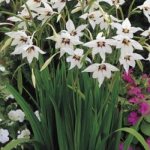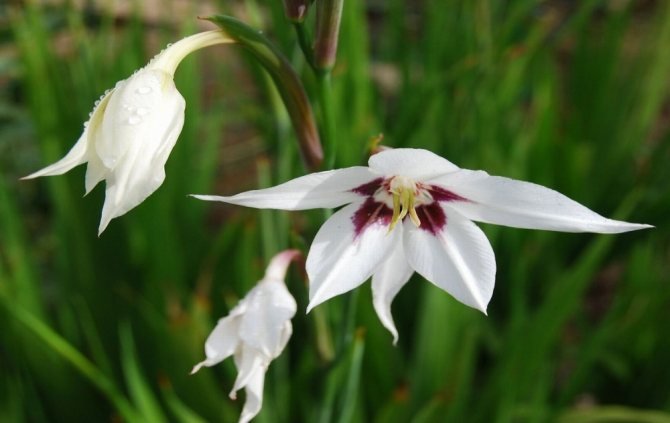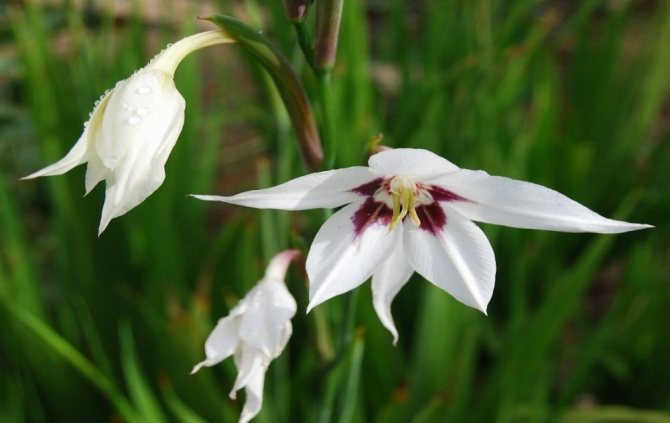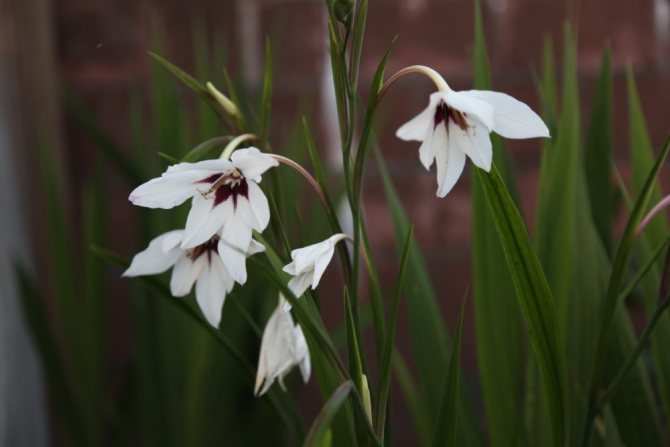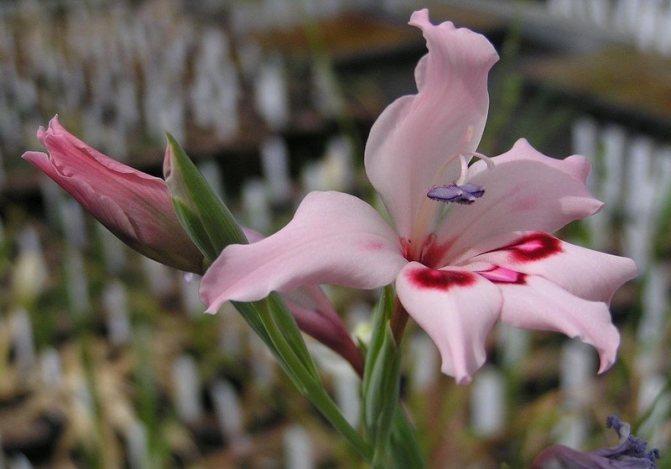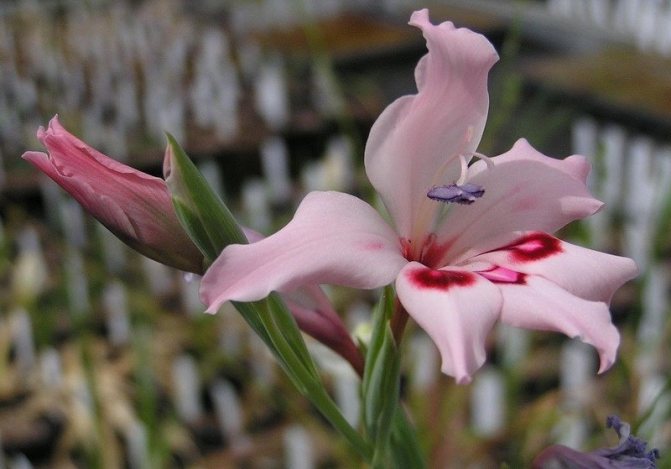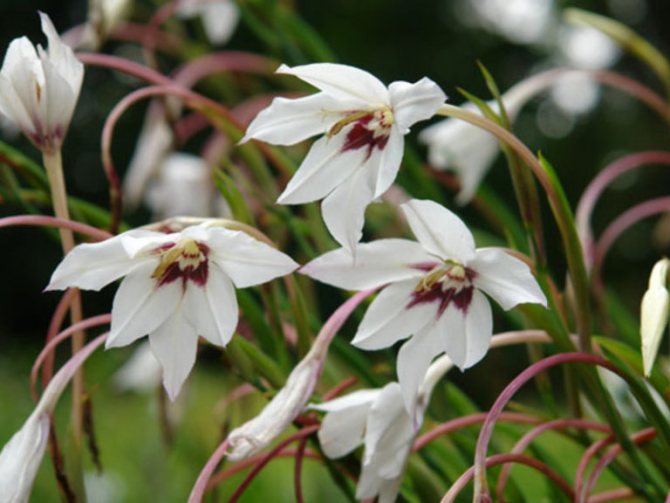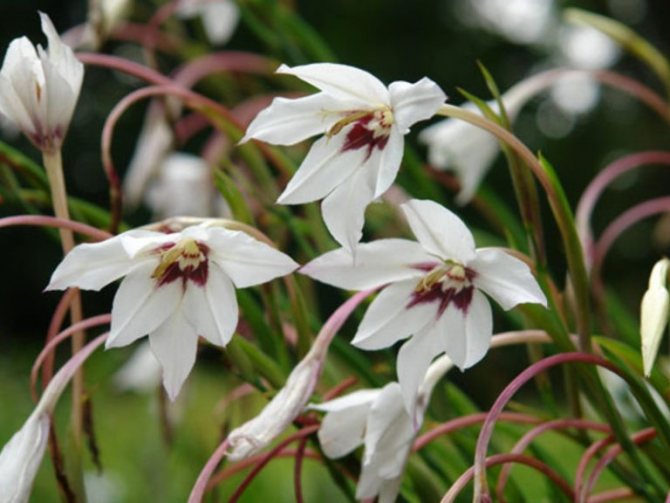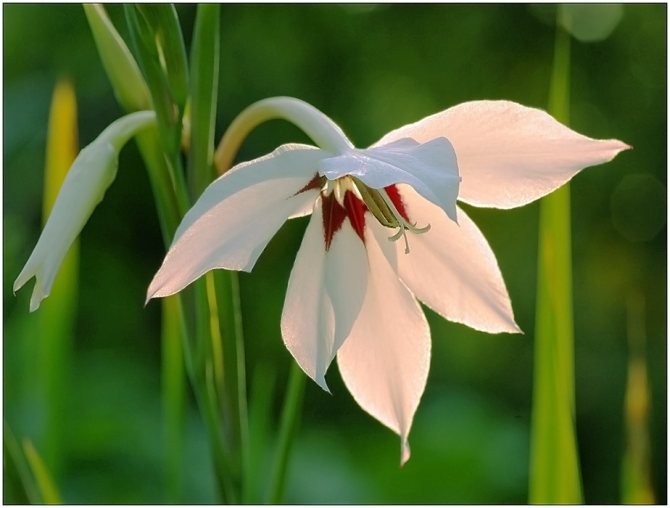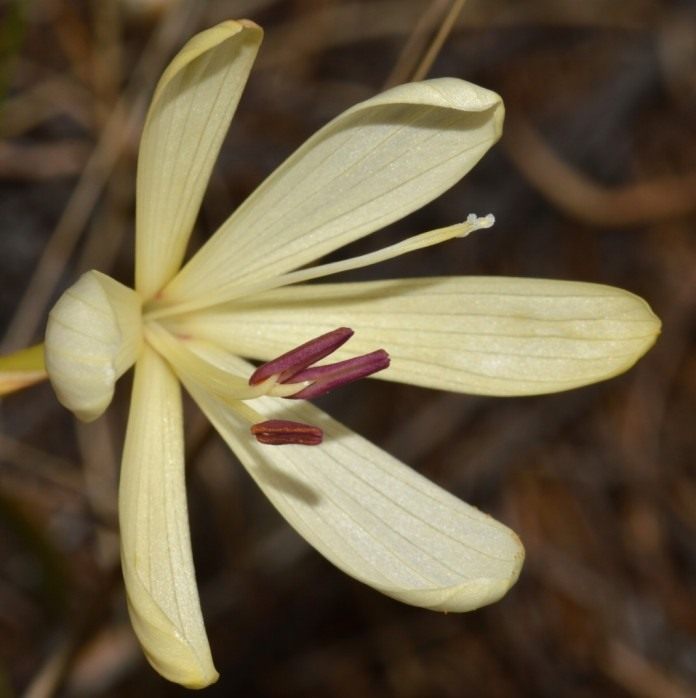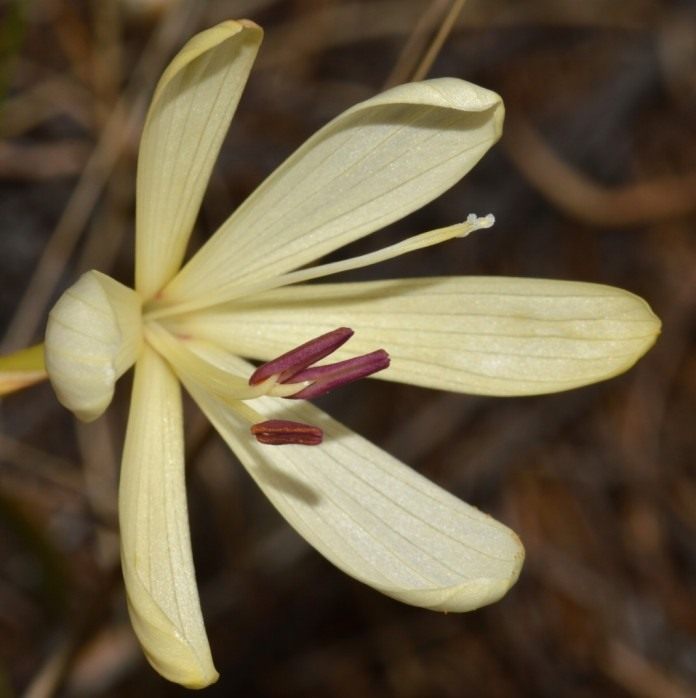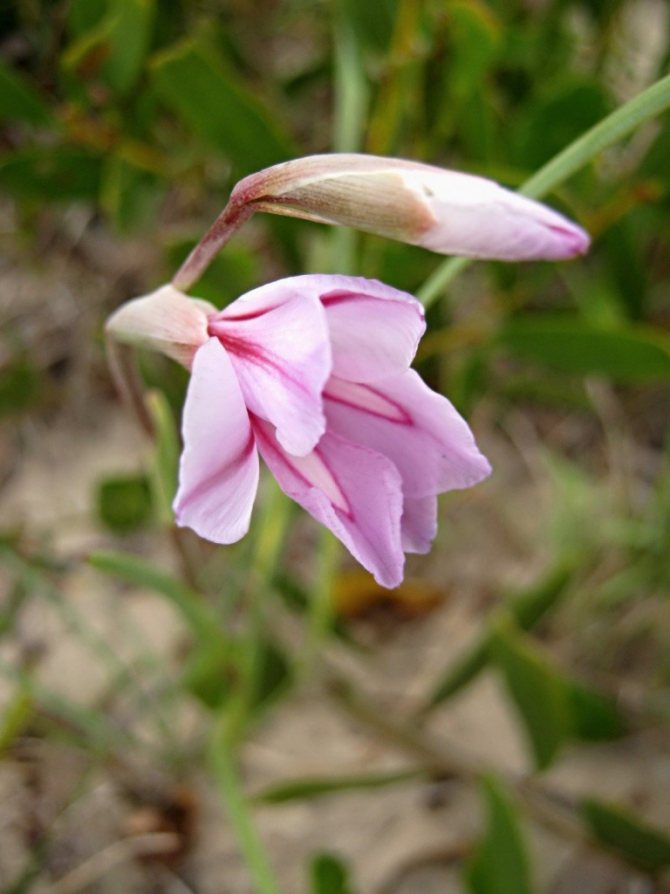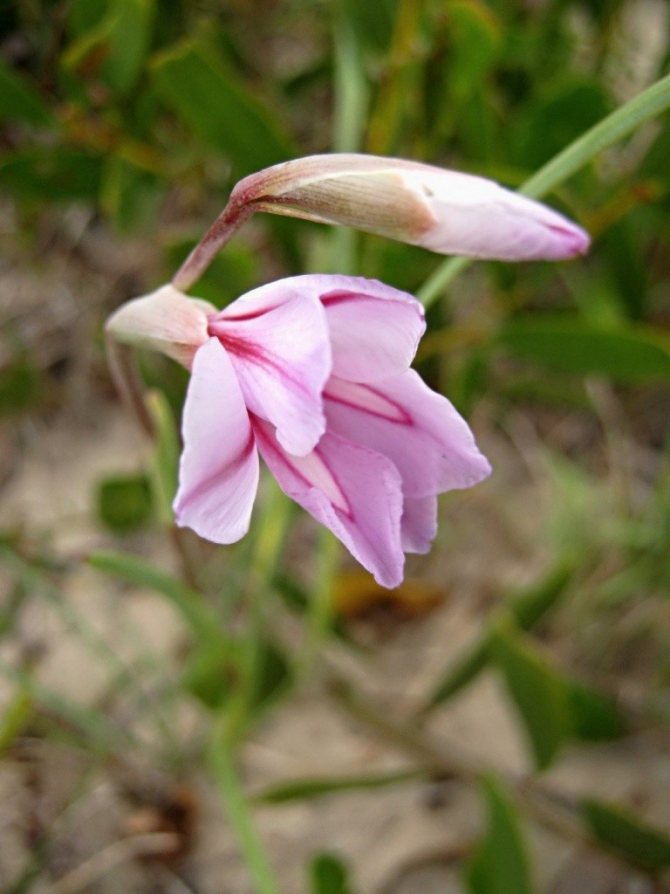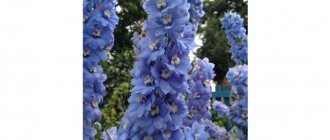Acidanthera is a herbaceous perennial plant that is a member of the Iris family. The name acidantera is derived from 2 Greek words, translated as "sharp" and "flower", this is due to the fact that the perianth of this plant has pointed lobes. This genus unites about 40 different species that can be found in natural conditions in the tropics of Africa. The most popular among gardeners is acidantera bicolor, or acidantera Muriel, or gladiolus Muriel, or skewer Muriel, or beautiful-flowered gladiolus, or fragrant gladiolus: the cultivation of this garden plant began in 1886, while earlier it was allocated to a separate genus. Today, this species is a representative of the Gladiolus genus, as well as the wild species of acidanthera, they are currently also called gladioli. But to avoid confusion, gladiolus Muriel is still called acidantera in special literature and among gardeners.
Description and characteristics of the Acidantera flower
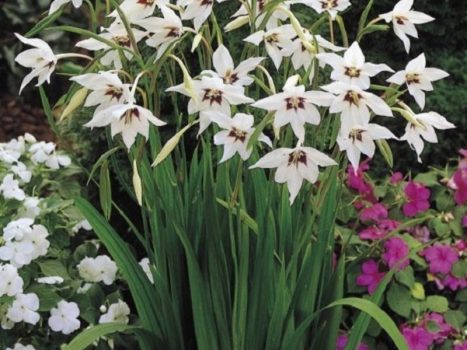
The genus of the family of this flower includes almost 40 species, which are mostly found in the African tropics. Outwardly, this flower resembles a gladiolus, for which it received its second name.
It has straight stems and linear leaves. The flowers themselves are large - 7-9 cm in diameter. They are graceful, emit a delicate aroma. Available in shades of pink, white, yellow or purple.
The flower tube is long, bent. The slices are uniform, gather in an inflorescence of 3-6 spikelets. The bulb has a rounded shape, about 5 cm in diameter, which is covered with a light brown shell on top. The fruit grows in the form of an elongated capsule.
Features acidantera
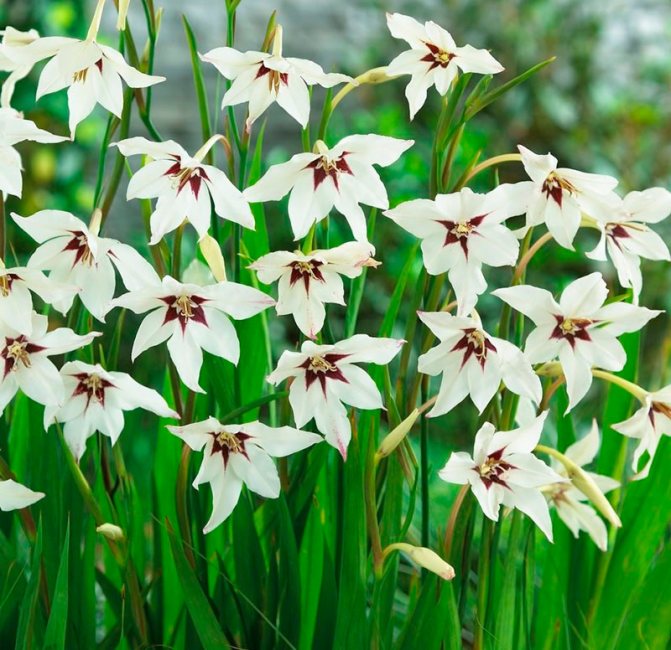

Acidatera Muriel is a perennial, which reaches a height of 1.2 m. Rounded corms, painted in white, reach 30 mm in diameter, they are covered with a dense brown shell. In the upper part, the shoots can be branched or simple. The length of the greenish leaf plates is about 50 cm, they have a linear or xiphoid shape. Spike-shaped inflorescences consist of 3-10 flowers of white-cream color, which reach 5-12 centimeters in diameter. The flowers have a pleasant sweet scent that is attractive to bees, they have a long tube, as well as 6 pointed petals, which, closer to the base, change their color to dark crimson, dark purple or almost black. Flowering is observed in August-September. The opening of flowers occurs alternately from bottom to top, in this regard, the duration of flowering of each peduncle can be up to four weeks. The fruit is an elongated capsule with seeds inside.
Advantages and disadvantages of the variety
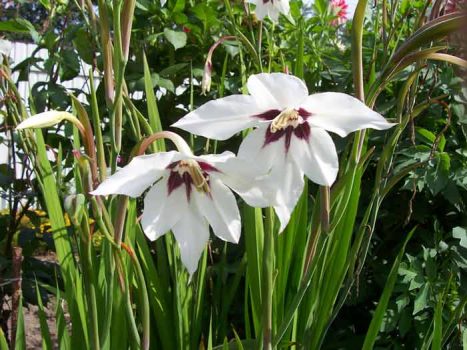

Like other flowers, scented gladiolus has advantages and disadvantages. Let's analyze the main ones.
Pros:
- Great appearance;
- Ease of landing;
- Unpretentious care;
- Low cost of seeds.
Minuses:
- The inaccessibility of seeds in our region
- Quite high cost
- The need to protect the plant from frost
Wintering
Do I need to dig acidander for the winter? If your region has warm winters and the soil does not freeze, you can leave the bulbs in the soil, just mulch the surface. And be sure to monitor the drainage so that the delicate bulbs do not get wet during the spring flood.
Preparing acidants for winter in the middle lane involves digging. The natural habitat of the fragrant gladiolus is Africa (Burundi, Ethiopia, Tanzania). Temperatures below zero tolerate negatively, therefore, bulbs are dug out in the middle lane for the winter.
Dig the acidander in the same way as gladioli - with a decent lump of earth so as not to damage the children. Faded plants are given time to accumulate nutrients in the bulb, then, without waiting for the first frost, they are dug up along with the leaves. The period of digging and wintering depends on the region - approximately the end of September, October, the beginning of November.
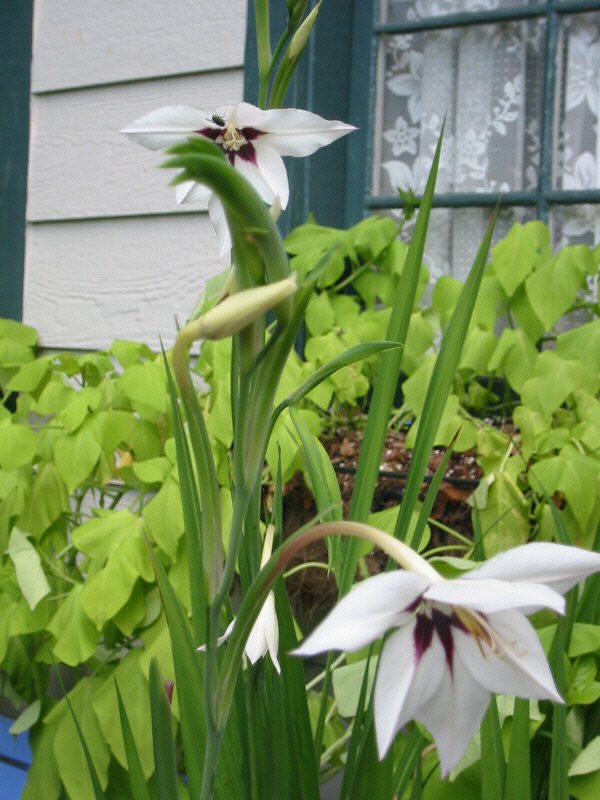

Types of varieties Acidantera
The acidantera variety has about a dozen different types. But, we will consider only those that are most often found in our country, and tolerate the Russian climate well.
Bicolor
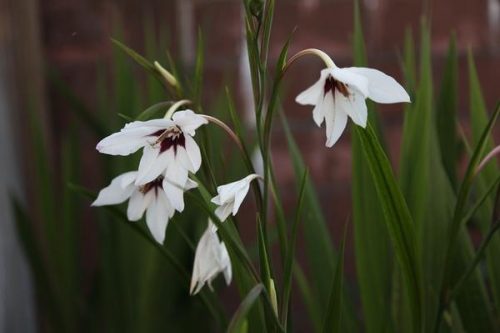

Most common. Brought to Russia from Ethiopia. The flowers strongly resemble gladiolus, but they do not nestle against the stem, but are located on long legs.
Muriela (Muriel)
Originally from the Cape South African Peninsula. It has white flowers with purple veins and a greenish spot in the throat.
Two-color white
It was discovered near the Dori River in South Africa. It has white flowers of a crimson hue with a spot in the throat.
When to dig
The time for digging up gladioli in the middle lane begins in the second half of September and lasts until the time when constant autumn frosts begin
It is important to take into account the fact that at least 40 days should pass after flowering. Only by this time will the bulb fully mature
How to tell when to dig up gladioli? You need to check for the plant itself. Whether the bulb is ready for digging is determined by the ground part of the gladiolus. If the leaves have withered and turned yellow, you can start. It is better to start by digging out the bulbs of varieties with dark colored petals (red, cherry, purple). Dark varieties are usually weak and vulnerable to fungal infections.
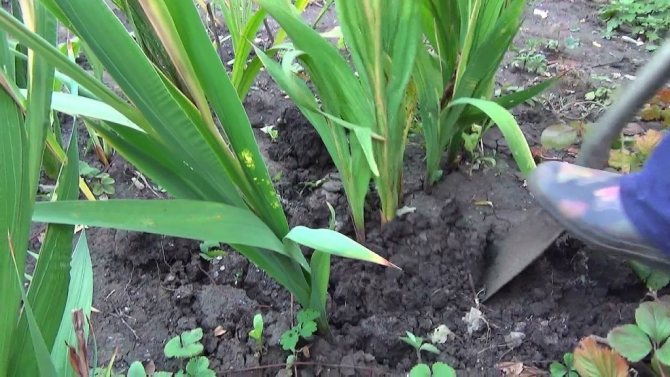

Digging up gladioli.
Gladioli, which were grown from "babies", should be the last to be collected and stored for digging and storage. It will be better if the digging takes place in dry weather. The dry soil will not adhere strongly to the bulbs. It is also easier to get all the children out of dry soil. Children "lost" in the ground will overwinter and in the spring they will "mix" the varieties in the flowerbed. This is undesirable.
If it is necessary to harvest the bulbs in the rain, they must be rinsed in running water and must be thoroughly dried.
After all the bulbs have been dug out, they must be "cut": cut off the roots, stems. Carefully, so as not to damage the bottom of the substitute bulb, the old bulb must be removed. After all the corms are processed as a preventive measure after digging. A weak solution of foundation is used, a pink solution of potassium permanganate. The bulbs are immersed in a container with a solution and kept for about half an hour.
If the gladiolus has been affected by insects or fungi, the bulbs must be burned. This is the only way to stop the spread of the infection.
After a preventive bath, the gladiolus bulbs must be thoroughly dried. Drying them at room temperature (22-23 C) lasts about a month. The bulbs should be laid out in one layer on a linen surface.
If possible, it is better to speed up this process with improvised means. To do this, you can use a hair dryer, special dryer or other heating device. If there is a danger of infection with a fungus, forced drying will prevent the disease from developing.
Rules for planting Acidantera flower in open ground
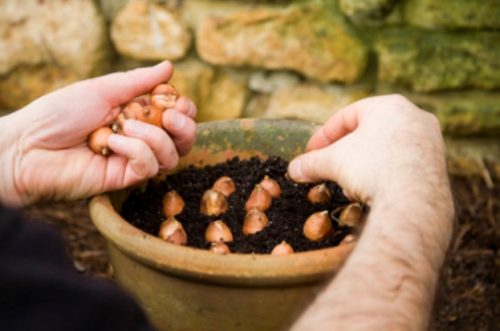

Acidantera bulbs must be planted in the spring.Their seme is laid in the ground to a depth of 7-13 cm, with a distance of 11-20 cm from each other, depending on the size of the flower.
In order for the acidantera to bloom as early as possible, it should be grown in small pots, starting in March. The diameter of the container should be 12-15 cm, and a maximum of 5 bulbs can be planted in one such pot.
Flowers grow in greenhouse conditions, or in a bright place in an apartment. At the end of May, plants can be transplanted into the garden. Adhering to this scheme, you can grow more powerful, abundantly flowering acidanters.
Important!
Acidantera is a plant that loves warmth. Therefore, it should be grown outdoors only in southern latitudes. If the climate is cool (like ours), then the best option is a greenhouse.
Acidantera: varieties and varieties
Acidantera is known to flower growers under other names. These perennial flowers are also called Muriel's gladiolus or skewer. In nature, the flower is widespread in tropical regions of Africa and Asia.
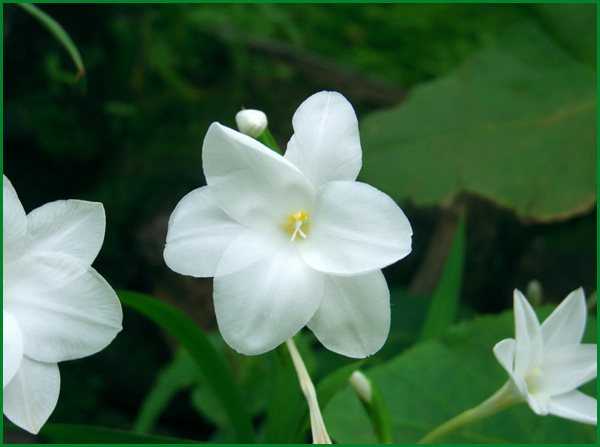

Acidantera white
Acidantera belongs to the Iris family. It is a bulbous herbaceous plant, the cultivars of which, when grown outdoors, reach a height of approximately 1 m. Possesses long narrow xiphoid leaves. The stem can be decorated with from one to ten buds. The flowers are medium in size, about 5-6 cm in diameter, with a pleasant aroma.
Florists are engaged in growing acidants not only in the garden, but also indoors. In the open field, the following varieties are propagated:
- Acidantera bicolor is the most common variety. Its varieties form up to a dozen buds on one plant. The petals are white with a bright purple base, which creates the effect of a colored center.
- Acidantera tropical is a tall perennial plant, the stem is up to 130 cm long. The flower combines pure white petals with large pink spots.
- White acidantera - stands out among other varieties with pure snow-white petals.
Care rules
Each plant (and acidantera is no exception) requires constant self-care and systematic inspection. Without this, the plant will simply wither, or will not live up to the expected results. How to care for acidantera.
Regular watering
As soon as the soil in the pot or garden begins to dry out, it must be moistened. But, it is important not to allow waterlogging.
Loosening
Once a week, the soil around the plant must be loosened.
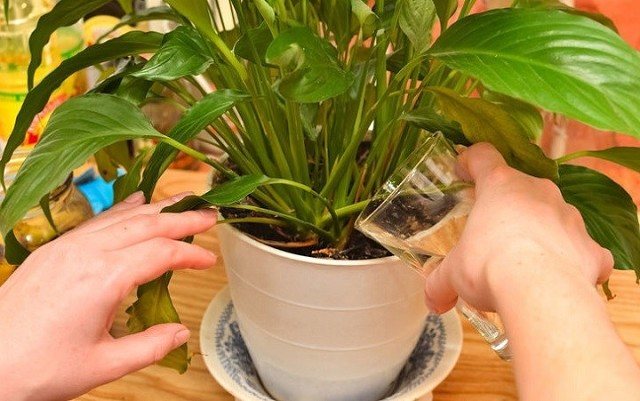

A remedy from which plants grow by leaps and bounds! Just water your plants with it Read more ...
Weeding
Weeds need to be weeded as they grow near the plant.
Top dressing


Produced weekly, using mineral fertilizers.
Plant care
Acidantera is undemanding to care for. But it should be borne in mind that this is a moisture-loving culture, so you need to moisten the flower bed abundantly. At the same time, water stagnation in the ground should not be allowed. This phenomenon is often observed on heavy soils. It is recommended to arrange drainage here so that the bulbs and roots do not suffer from excess moisture.
Advice. It is useful to combine watering with loosening the beds and mulching the soil.
The perennial is a thermophilic plant and it is undesirable to leave the bulbs in the open field for the winter. With the advent of persistent cold weather, they are taken out of the ground.
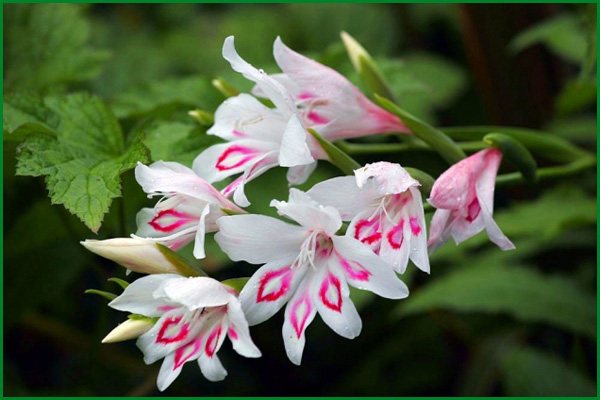

Acidantera tropical
Before being sent for storage, the planting material is allowed to dry thoroughly at room temperature. This process takes 3-4 weeks. After that, the bulbs are laid out in paper bags and kept at a temperature of + 15 ° C until the spring planting.
Reproduction
The acidantera flower, similarly to gladiolus, can multiply by seeds, bulbs (corm babies). Let's consider each of the methods in more detail.
Seeds
The method is rarely used, since the flowering of the plant will have to wait for a very long time.Its scheme is as follows - at the end of March, the seeds must be planted in a fertilized, mineral-rich loose soil, and sent to a room with a temperature of 20-25 degrees. Of course, the seedlings must be constantly monitored.
Bulbs
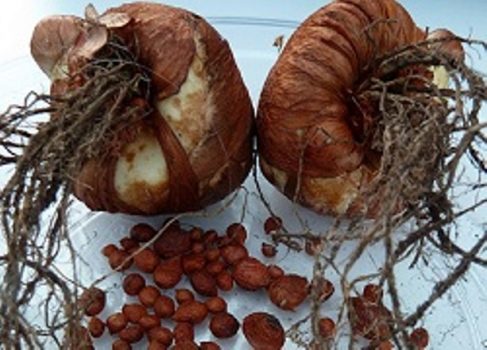

Many babies form on the bulbs. In the spring they need to be planted in grooves or containers with loose soil. Systematically you will have to do weeding, add water, and loosen the soil. After a couple of years, nodules will grow, which can be transplanted to a permanent place.
Acidantera growing from seeds
Areca chrysalidocarpus features of care and cultivation
Acidantera can be propagated by tubers (bulbs), babies and seeds.
The seed method is used very rarely, this is due to the fact that from such specimens, it takes a very long time to wait for flowering. The seeds are harvested in the fall or purchased from flower shops.
Sowing seeds for seedlings is carried out in February. To do this, over the pre-calcined earth (warm it up in an oven to get rid of bacteria and parasites), seeds are sown and sprinkled with a small amount of soil, moistened and covered with foil or glass.
Ventilate from time to time and, if necessary, humidify with a spray bottle. The optimum temperature of the content is + 20 ... + 24 ° С. In two to three weeks, friendly shoots will appear, which dive into small pots, in which they will grow for two to three years, until the tuber grows to such an extent that it can provide flowering. After the first flowering, young seedlings can be safely planted (in the spring) in open ground.
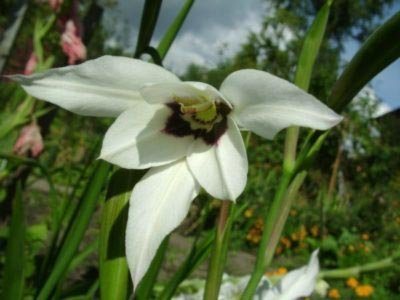

Possible diseases and pests and methods of dealing with them
Acidantera in a suburban area can be devoured by pests such as snails and slugs. Therefore, before planting the plant, the bulbs must be carefully treated with fungicides, which will also protect the plant from dry and soft rotting in the future.
The first sign of decay is dark, close to the color of rust, spots, which are most often located on the leaves of the flower. Having found such a spot, the affected leaf must be removed.
In addition to pests, the flower can become infected with a variety of viral infections. Therefore, the soil must be systematically fertilized with special dressings that protect it from microbes, and the leaves must be treated with antiseptic agents.
To get a good harvest, you need to use quality seeds. The most productive varieties are possible. A large selection of varieties for every taste.
Soil preparation and planting
Features of home care for the Radermacher flower
Planting an acidander flower and caring for it does not cause any particular difficulties, but nevertheless, some nuances must be taken into account.
The soil should be neutral or slightly acidic. If the soil is too acidic, it will be limed.
Do not get carried away with abundant watering, since the tubers of the plant are prone to decay. To ensure moderate soil moisture, it is recommended to cover the soil surface with a layer of peat after planting the plant. Before planting, it is necessary to fertilize the land with mineral and organic fertilizers. Rotten leaves, humus, old sawdust are suitable for this purpose.
In order to speed up the flowering of acidants, some growers prefer to germinate the plant in pots first. Sowing should begin in March, and when the frost ends (end of May), you can start planting seedlings in open ground. Such sprouted tubers are planted shallowly into the ground (no more than 5 cm).
Two weeks before planting, the bulbs are taken out of storage so that they are thoroughly warmed up. Then they are sorted by size, discarding the rotten and spoiled ones. A healthy bulb is usually milky, dry, covered with a light brown shell.To protect against pests, the bulbs are soaked in a weak solution of potassium permanganate before planting.
Corms are planted in prepared holes. If group plantings are required, rows are made. The planting depth is 8-12 cm, and the distance between the holes should not be less than 20 cm. If the planting material is used as planting material, the planting depth is approximately two bulb diameters.
Preparing for winter
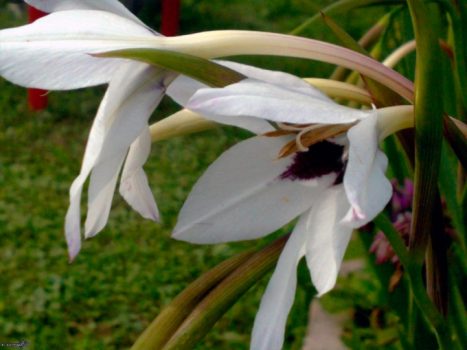

When the flower has completely bloomed, you need to stop fertilizing it and minimize watering. The peduncles are cut off, and the leaves are left at the bottom - they are necessary for feeding the tubers.
With the onset of winter, the tubers with leaves must be dug up together. Then the stems are separated from the bulbs (about 2 cm is left). The tuber is cleared from the ground, and the children are carefully separated from it.
How to store acidander at home in winter
After the tubers are dry, they need to be placed in a warm room with a temperature of 20-22 degrees, and kept there for a month. Then they need to be cleaned of scales, remnants of leaves and roots.
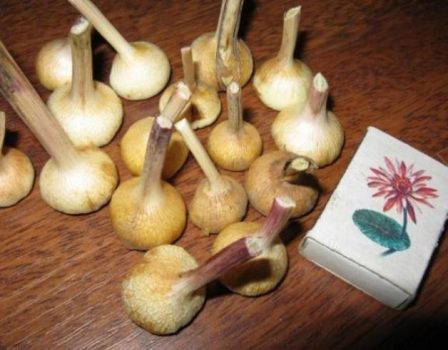

Then each onion is wrapped in a paper napkin, folded into a paper perforated bag (for air circulation), and sent to storage in a dark place with a temperature of about 15 degrees.
Helpful advice!
Before planting the bulbs again, they should be heated in a room with a temperature of 20 degrees for a week.
Corm storage
In the fall, it is imperative to dig up the acidander. This should be done in October. If this rule is neglected, then the acidander will most likely freeze or weaken very much. Dug out bulbs must be dried.
After 3-4 days after digging, old bulbs and rhizomes are separated. You should not do this right away, because during separation there is a risk of damage to the bottom. Already processed bulbs are stored for a month in the warmest place of an apartment or house. For example, on the top shelf of a kitchen cabinet. This will prevent further decay. For preventive purposes, to combat diseases and pests, tubers should be treated with fungicides.
In winter, corms are stored at a temperature of 4-6 degrees. If the amount of planting material is small, then you can wrap it in paper, then in a plastic bag and put in the refrigerator. Bulbs can dry out at room temperature. In this case, you can use the following method: the tubers are placed in a three-liter jar, filling it halfway so that there is enough space for air, and covered with a plastic lid. You can additionally make two or three holes in the lid.
Acidantera in landscape design
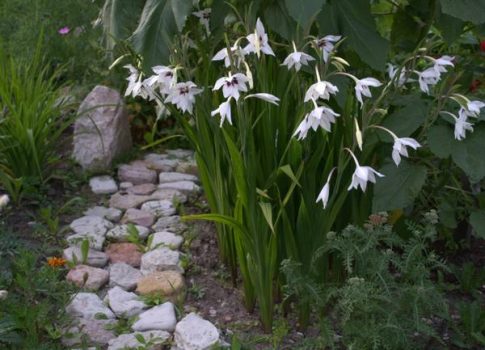

Acidantera is an incredibly beautiful plant. Therefore, it is often used in landscape design. With the help of acidants, they decorate flower beds and artificial reservoirs, alpine slides, etc.
Moreover, a very pleasant, sophisticated aroma of flowers can be called a "bonus" of this design, which will accompany homeowners in the gazebo, in the yard, near the bench, etc.
Acidantera looks most impressive when planted in groups, or in combination with other plants: sage, perennial, aconite, aster, and all others, the flowers of which have a red or purple hue.
Biological characteristic
The name "acidantera" comes from the Latin acidanthera, which means acidos - sharp and anthos - flower. The plant got this name because of the pointed petals. Some growers call the flower "fragrant gladiolus" because of the extraordinary aroma emanating from the plant during flowering.
Acidantera is a herbaceous bulbous perennial belonging to the Iris family. The underground part is represented by corms measuring 5-6 cm in diameter and having an oblong shape. The stem is erect, reaching a height of 1 meter.Leaves are narrow and long, mostly located at the base of the stem. There are quite a few of them on the upper part of the shoot.
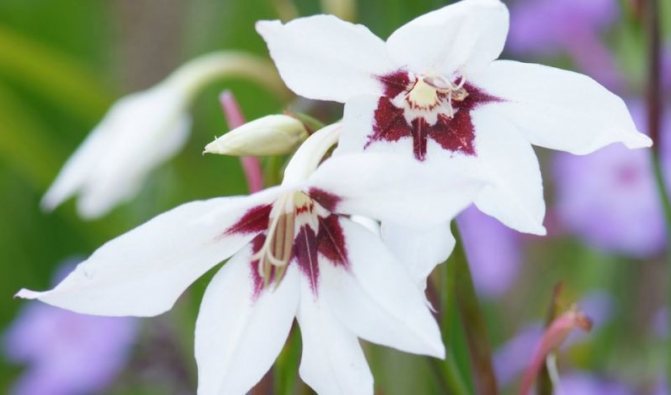

The color spectrum of inflorescences is very diverse: light lilac, yellow, pale pink, cream, milky. Acidantera blooms at the end of summer and continues to delight until the first frost. Then an elongated seed capsule is formed, filled with small seeds.
How to water and feed acidander
This culture needs systematic and moderate irrigation, especially when hot, dry weather is observed for a long time. It should be remembered that this flower does not tolerate both drought and stagnation of liquid in the ground. If the plant is flooded, it can lead to the appearance of rot on the root system. During flowering, watering should be reduced, but the soil on the site should always be slightly damp. During watering, care must be taken that liquid droplets do not fall on flowers and foliage, otherwise burns may form on their surface. You need to water the flowers with settled water, which should not be cold. After the liquid is completely absorbed into the soil, its surface should be loosened, while pulling out all weeds.
It is necessary to feed this flower crop with mineral complex fertilizers that are applied to the soil. During the season, it should be fed 2 or 3 times. The first time the plants are fed with organic fertilizers, the second time - during the active growth and build-up of the green mass, fertilizers containing nitrogen are used for feeding, and shortly before the beginning of budding, a phosphorus-potassium complex should be added to the soil. They feed the Acidantera, as a rule, at the same time with watering. Such a plant cannot be fed with fresh organic fertilizers.
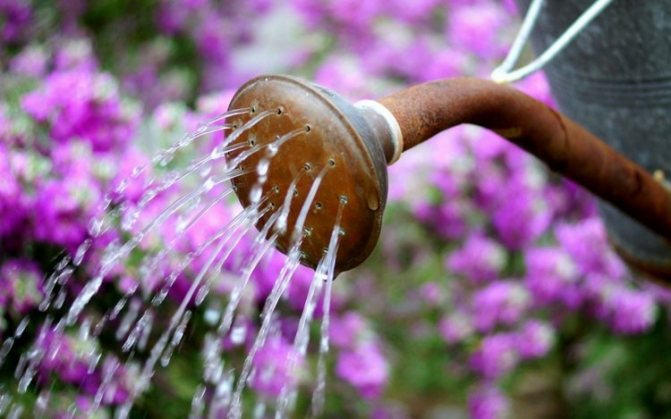

Answers to topical questions of florists
Question number 1.
Why didn't Acidantera bloom at all, but instead the number of tubers doubled?
This may be due to a number of factors. There was no drying, so the bulbs did not bloom. If there was drying of the bulbs, then the reason was improper care of the plant. Most likely Acidantera was overfed. With an excess of nitrogen, plants multiply more strongly, rather than bloom. It can also be from planting too deep in cool and wet weather.
Question number 2.
I bought Acidanthera bulbs in the garden center. I chose the largest ones, but, nevertheless, they are quite small. How to deal with them?
In our gardening stores, Acidantera babies are mainly sold, and not adult bulbs. Children can be planted side by side, in front of adult plants on the sunny side. Before that, pre-soak for 5-6 hours and remove the skin.
Question number 3.
Do I need to green the young Acidanthera bulbs?
No need to green up. It can be pickled in a fungicide solution, and while the onions are soaked in it, the husks will peel off by themselves. And you can plant. Small bulbs on the window will dry out quickly without having time to turn green.
Question number 4.
What can be done to make acidantera bloom earlier?
To do this, you can germinate the bulbs in pots on the windowsill in March.
And the cydantera, or gladiolus Muriel (Gladiolus murielae), was not accidentally ranked among the genus Gladiolus. The rules for growing acidantera and gladiolus are largely similar, which means they are familiar to many and not burdensome. (You are reading the continuation of the article about Acidantera, or Gladiolus Muriel. See the beginning of the article)
Growing acidants.
In the acidander's garden, it is better to take a sunny place, in extreme cases, light partial shade. In the shade, the flowering of acidantera turns out to be weak, sometimes completely absent. Although the peduncle of acidantera is strong and rarely needs tying, it is better to plant it in places protected from the wind. Acidantera is not demanding on soils.In addition to heavy clay soils, it can grow on almost any soil, including shallow soils. Therefore, acidantera is well suited for container planting and can be grown as a houseplant. Acidantera grows well in moist, drained soils. The topsoil, where tidantera grows, should never dry out. But pouring acidanter is as harmful as not topping up, and here it is necessary to observe the measure. Stagnation of water in the soil is especially dangerous for acidanders, from which its corms can rot. The best flowering acidantera in the garden can be obtained when growing light, fertile, drained soil of slightly acidic reaction. Therefore, before planting, the soil is dug up and well filled with organic and mineral fertilizers. In open ground, corms are planted with acidants after the threat of frost. However, when planting this thermophilic plant in late May - early June, it is not always possible to achieve full flowering. In a cold and rainy summer, acidander may not bloom at all.
Growing up acidants.
Acidantera is often planted in the soil in a grown state. In this case, it manages to bloom magnificently and for a long time during August and early September, and the corms have time to supply enough nutrients for flowering next year. In March, acidander corms are taken out of storage and placed in the light at room temperature so that they start growing and give an arrow. After that, the corms are planted in pots with soil and grown until April on the windowsill. In mid-April, pots with acidantera can be transferred to a loggia or a greenhouse, and in May they can be planted in warm soil or in containers along with a lump of earth from the container so as not to disturb the roots.
Acidantera. Planting and leaving.
Acidantera is planted in the soil to a depth of 8 cm, depending on the size of the corm, leaving a distance of 12 cm between the plants. Acidantera loves moisture, so in summer, especially in hot weather, it needs watering. Since the beginning of flowering, watering is somewhat reduced. Once every 10-14 days, the acidander is fed with instant complex fertilizers, combining top dressing with watering. To prevent moisture evaporation, the soil where the acidantera grows is mulched using the usual methods: peat, humus, grass cuttings, etc. Mulching also helps prevent weeds. During the growing season, they monitor diseases (rust, powdery mildew, root rot, wilting, mosaic) and pests (thrips, aphids, spider mites, slugs) that can affect plants. In the event of these problems and for their prevention, drugs from the store are used. After flowering, the peduncles are cut off so that the acidantera corm can ripen. Indeed, if the seeds ripen, the acidander will not store nutrients in the underground organ, and the seeds will give flowering plants only after a few years. In order to extend the growing season, acidants and protect them from spring or autumn frosts, during these periods the acidander is covered with lutrasil (or other material) or the containers are transferred to a warm place.
Storage of corms acidantera.
In the fall, acidanters dig up corms for storage, usually at the end of September. The upper leaves of the plant are cut off, leaving the lower ones, and dried for 2-4 weeks in the shade in a ventilated room at a temperature of + 18-20 ° C, for example, in the attic. Before drying, the corms are recommended to be kept in any fungicide for plants according to the instructions. When the corms are dry, the dried surface of the acidantera can be easily removed by unscrewing. The roots are cut off the dried corms and placed in storage. Acidantera corms, like gladioli, are stored in a dry ventilated room at a temperature of + 10-15 ° C, wrapped in thin paper such as newspaper. You can put the corms in a box with peat, perlite, vermiculite.When corms are stored at lower temperatures, their flowering is delayed or completely absent. It is not always possible to save corms. Often they do not have time to accumulate nutrients during the growing season and become unviable. Therefore, lovers of these plants annually buy new acidantera corms.
Reproduction of acidants.
Acidantera can be propagated by corms, babies and seeds. Seed propagation is rarely used in amateur floriculture, since after it you have to wait a long time for acidantera to bloom. More often, acidander is propagated by children, of which a lot is formed on the corm. They are planted on the growing beds and carefully looked after: watered, fed, loosened the soil, weeded, dug up for winter storage. Only after 2-3 years do such corms reach the size that can form flowers. With good care, acidantera corms can live up to 5 years or more.
Having gotten to know more about Acidantera, or Muriel's gladiolus, you shouldn't have any difficulty in growing these flowers. Therefore, we wish you to fully enjoy the grace and armata of acidantera, wherever you grow it, in the garden or on the loggia. Good luck to you!
Photo: Acidanthera. She is Gladiolus Muriel (Gladiolus murielae), Acidanthera bicolor (Acidanthera bicolor), Acidanthera murielae, Gladiolus callanthus (Gladiolus callanthus) (Gladiolus murianthus)
Types of acidants: photo
Diseases and pests
Both in the garden and at home, the acidander is in trouble.
| Disease / pest | Symptoms The reasons | Prevention and elimination measures |
| Rot | Rusty, dark spots. Failure to comply with the watering regime. | Fungicide treatment, 1% bordeaux liquid. |
| Snails | The presence of insects. | Ammonia, mustard powder. In case of infection: removal of insects and affected foliage, treatment with insecticides (Fufanon). |
| Slugs | ||
| Aphid |
Description of the plant
Acidantera is a perennial herb that forms corms underground. It represents the iris family and grows in the wild exclusively in the warm countries of Africa and East Asia. Other flower names:
- fragrant gladiolus;
- beautifully flowered gladiolus;
- gladiolus callianthus.
Flowers form narrow bushes up to 1 m high. The rosette includes long, xiphoid leaves, painted in bright green. Flowering begins at the end of summer and continues until the very cold. Acidantera cannot bloom profusely, but it successfully compensates for this with the graceful shape of the flower and its sweet alluring aroma. The diameter of the open bud is 5 to 8 cm. It has only 6 petals in the shape of a pointed triangle. The color is white at the edges, but at the base it is dark - crimson, purple or even almost black.
Acidantera is suitable for growing both separately from other plants and as part of flower arrangements. It can be planted with annual and perennial flowers. It is convenient to grow fragrant gladiolus in a flower bed together with plants that bloom at different times. In this case, the flower garden will look lively throughout the summer.
Choice of place and conditions of detention
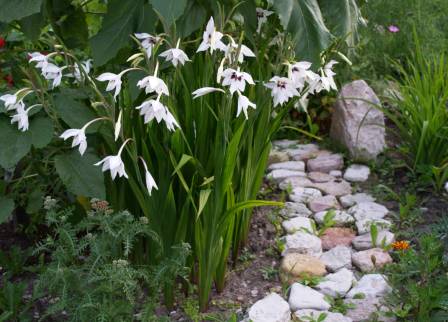

Let's find out what conditions are suitable for growing acidantera in the open field.
Lighting and location
The plant prefers to grow in an area that is well lit by the sun throughout the day. It will be able to grow in the shade and partial shade, but the lack of sunlight will certainly affect the condition of the flower. It will be rare and frail, and the bloom will be short and inconspicuous.
Temperature
Acidantera loves warmth very much. It is important for her that the temperature is kept at the level of + 20 ... + 24 ° C. And if summer is rarely warm in your region, then it is better to keep the plant in a greenhouse or greenhouse. Flowers die in winter when the air temperature is -13 ... -12 ° C.Particularly winter-hardy varieties can withstand frosts down to -20 ° C. But this is still not enough. Therefore, the corms must be dug up for the winter.
Air and humidity
Acidantera loves humid air (70-80%). Therefore, it needs special care during a drought. The area on which the flower grows must be protected from drafts, as it does not tolerate sudden gusts of wind.
Priming
Acidantera prefers a humus-rich, loose and well-drained soil with a slightly acidic reaction. It responds well to the introduction of humus, compost, peat and sand into the soil if the soil is too heavy.
Acidantera bicolor
Acidantera has a delicate but rather intense aroma. For this property, she was dubbed the fragrant gladiolus. In a separate culture, two-color acidander was brought out in 1896.
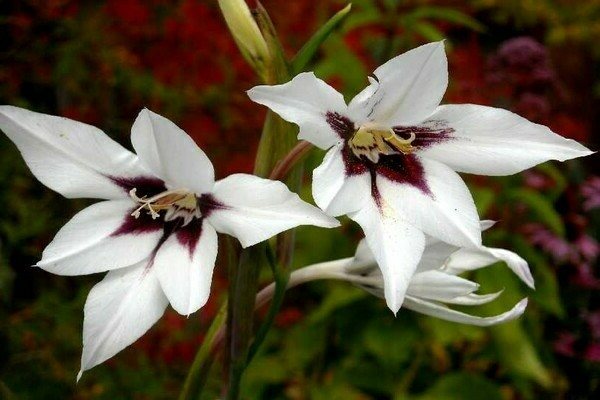

Acidantera
In the natural environment of this plant, there are about 40 species. Thanks to the crossing of this flower with gladiolus, breeders have bred many fragrant hybrids. The most popular of these hybrids is the Lucky Star Gladanter variety.
Planting material
Like many bulbous crops, acidantera can be propagated vegetatively or by seed. Both methods have their adherents, but vegetative propagation is much easier.
Seeds
The seeds can be purchased from a specialty store or ordered online. Sometimes the seeds are obtained after the plants have flowered, but in this case they must be allowed to ripen until the seed pod is completely dry. In the case of buying a bag of seeds, you need to pay attention to the date of packing, since after the third year their germination decreases sharply.
Sowing seeds is performed in late February or early March. Previously, this should not be done, since the sprouts will not have enough natural light due to the short daylight hours. For germination, a temperature of at least 20-25 ° C is required. A loose soil with high permeability and a rich supply of organic matter is selected.
The seeds are sown on the soil surface and lightly sprinkled with earth, after which the planting should be abundantly moistened with a spray bottle. To create a mini-greenhouse, the container is covered with glass or film. Seedling care consists in periodic airing and watering of the ground.
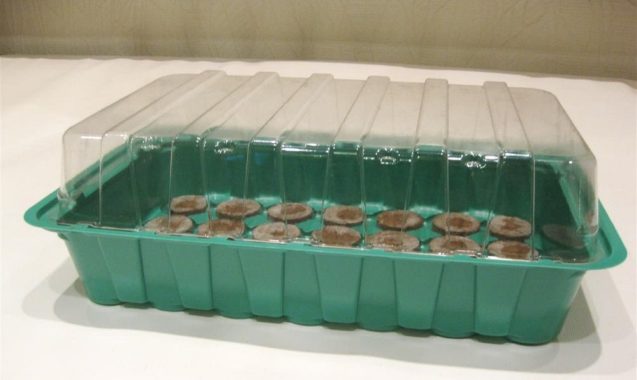

After a few weeks, the first shoots will appear, which should be cut into separate pots. There they will develop for a couple of years, gaining mass.
With seed reproduction, flowering will not occur until the third year after sowing.
After the plant blooms for the first time, it can be planted in the open ground in a permanent place in the spring.
Children
Many babies grow on corms every year. In order for them to develop normally, they must be disconnected from the mother's bulb during transplantation. They need to be placed in permeable soil where they will grow for two years. Care at this time consists in weeding the beds, timely watering and loosening the soil.
For the winter, every time young bulbs must be dug up and sent for wintering, since they will not tolerate a cold snap below 5 ° C.
Bulbs
The easiest and most reliable way is to purchase ready-to-bloom bulbs. In order for the buds to appear already in the year of planting, the size of the bulb must be at least 3 cm in diameter, it must not look shriveled and dry. It's also important to look out for mold or rotten spots. All defective material must be removed immediately, otherwise it can spread the infection to neighboring flowers during cultivation.
Common mistakes made by florists when growing acidants
The most common mistake in the cultivation of a bulbous plant is the choice of a shaded area.
A plant native to the tropics does not tolerate a lack of lighting, develops inactively, blooms with small flowers.
Improperly adjusted watering leads to various diseases - fungal or bacterial.
The ground part, hastily cut off after flowering, does not contribute to the formation of a strong bulb, ready to endure wintering staunchly.
Often she frowns and by the spring looks emaciated and not ready to give life to a healthy plant.
Planting acidants
This plant prefers places that are well lit by the sun.
Important! You should know that acidantera is a very thermophilic plant and is more suitable for growing in the open field in southern latitudes. In cool climates, the crop is best grown in a greenhouse.
Fertile, but light, slightly acidic or neutral soil with good drainage is suitable for planting a plant. Before planting, you can add a little peat to the ground.
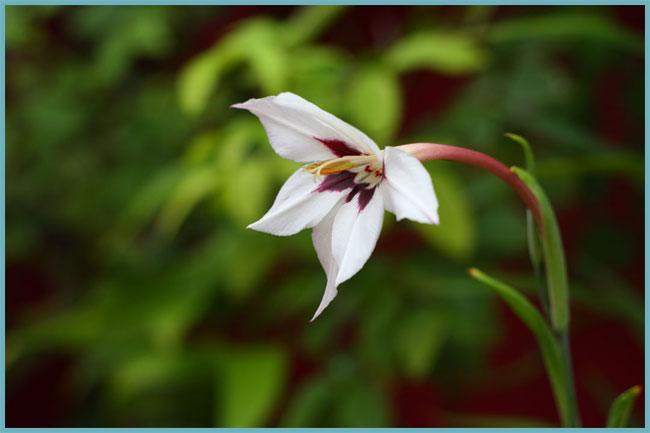

Planting acidantera is very simple: choose a sunny spot and plant sprouted bulbs
In spring, tubers can be planted immediately in open ground, but only when the ground has already warmed up well. Planting depth - 12 cm (to the bottom of the bulb). It is necessary to observe the distance between the tubers: if the bulbs are small, then it is enough to distance them from each other by about 12 cm, if large - then by 20 cm.It is recommended to add a little river sand to each hole when planting. Water well after planting.
But it is better to germinate the tubers a little before planting in the ground. To do this, at the beginning of March, plant the bulbs in a flower pot, burying them 3-4 cm into the ground. Up to six tubers are placed in a flowerpot, about 15 cm in diameter. Until May, the flowerpot should be placed in a warm, well-lit place, and do not forget to water it regularly. Then plant it on a flower bed. This method will allow you to get more hardy and strong plants with abundant and long flowering.
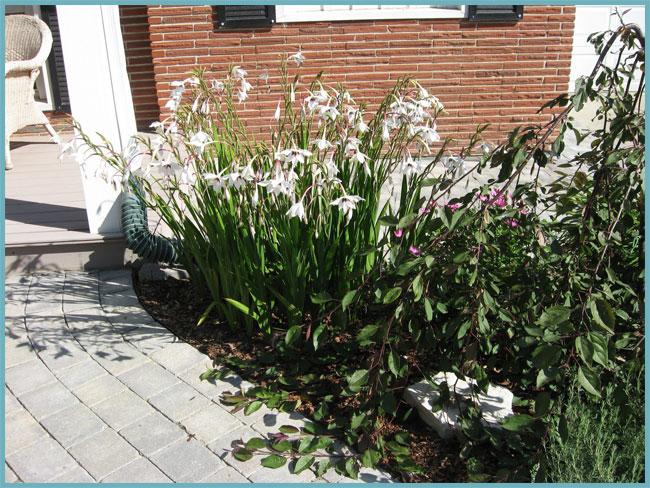

In the spring, plant the plant only when the soil is already well warmed up.
Acidantera - home care
Temperature conditions ... Normal room temperature.
Growing acidaters - lighting ... In the sun. In shading, the flowers become smaller or do not bloom at all.
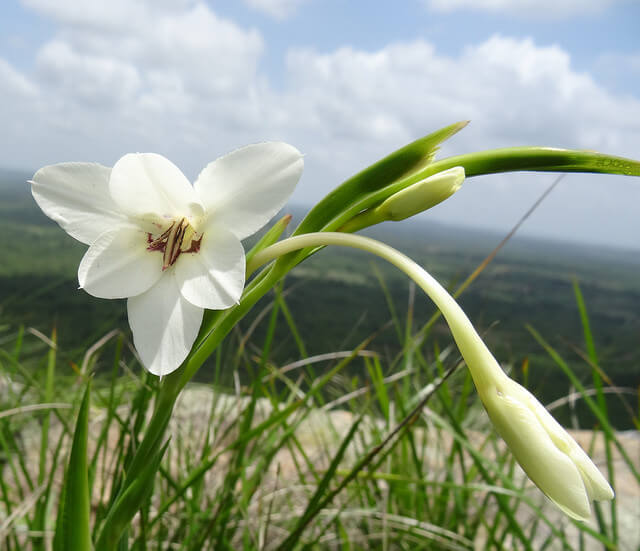

Care ... At the beginning of spring, the tubers are planted in a pot, while flowering occurs at the end of summer. After flowering, the tubers are removed from the soil and stored in a cool dry place.
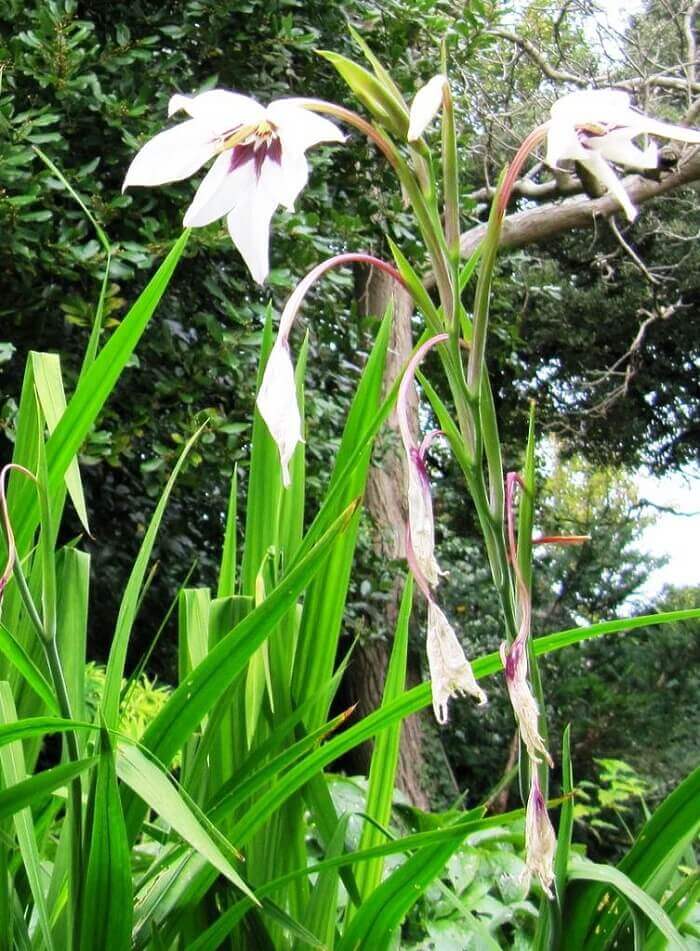

Substrate ... Fertile, well-drained soils with the addition of coarse sand.
Potted acidantera - top dressing ... This plant highly appreciates regular feeding, its flowers increase in size.
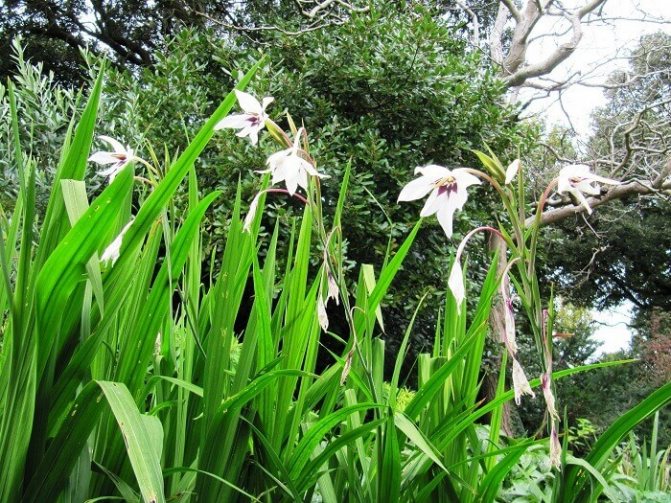

Appointment ... Indoors it is used as a plant for forcing, it is also suitable for cutting. The flowers are extremely fragrant with a slight scent reminiscent of gardenia or jasmine, which intensifies at night.
When acidander blooms ... August.
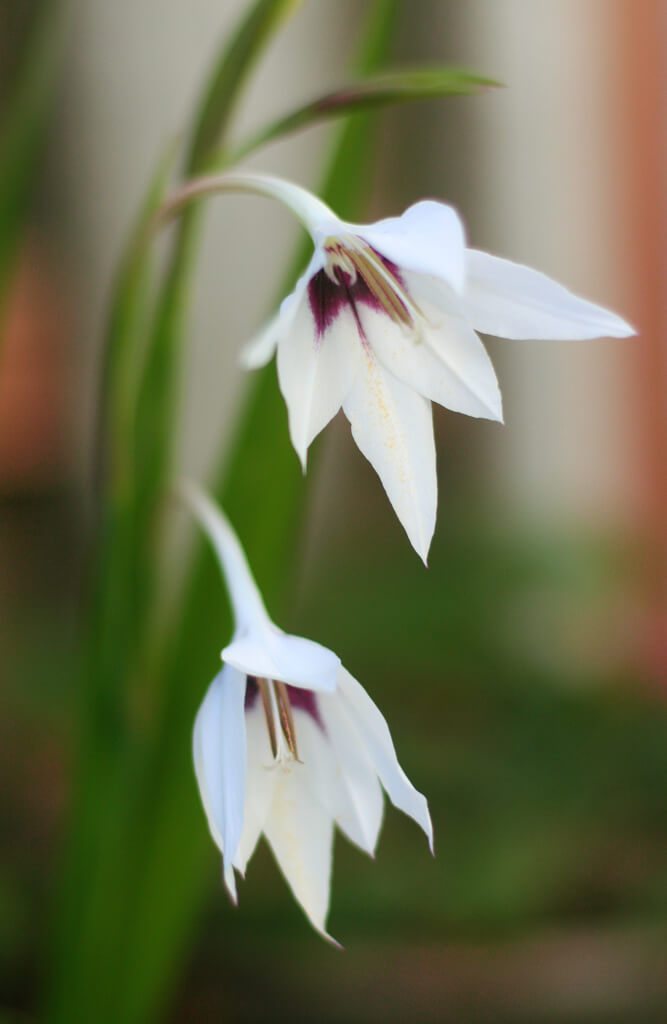

Air humidity ... There are no special requirements, the acindanter flower easily tolerates the rather dry atmosphere of living quarters.
Watering ... Periodic moderate watering during the growing season when growing in a pot, but does not tolerate overdrying.
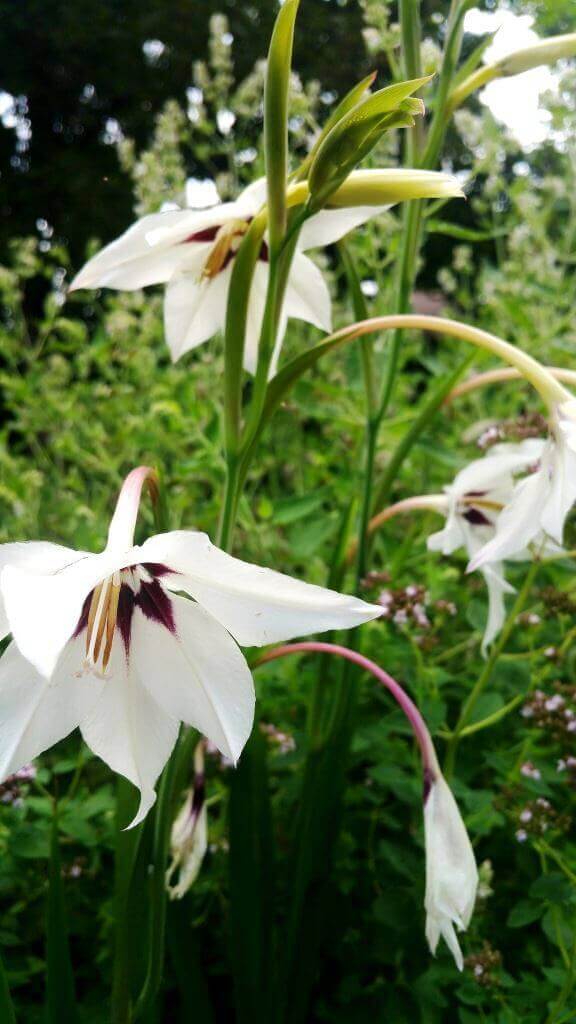

Acidantera landing, transplant ... Not necessary as it is often grown as an annual. Planting of bulbs is carried out by acidants in the spring, annually.
Acidantera reproduction ... Children of bulbs.
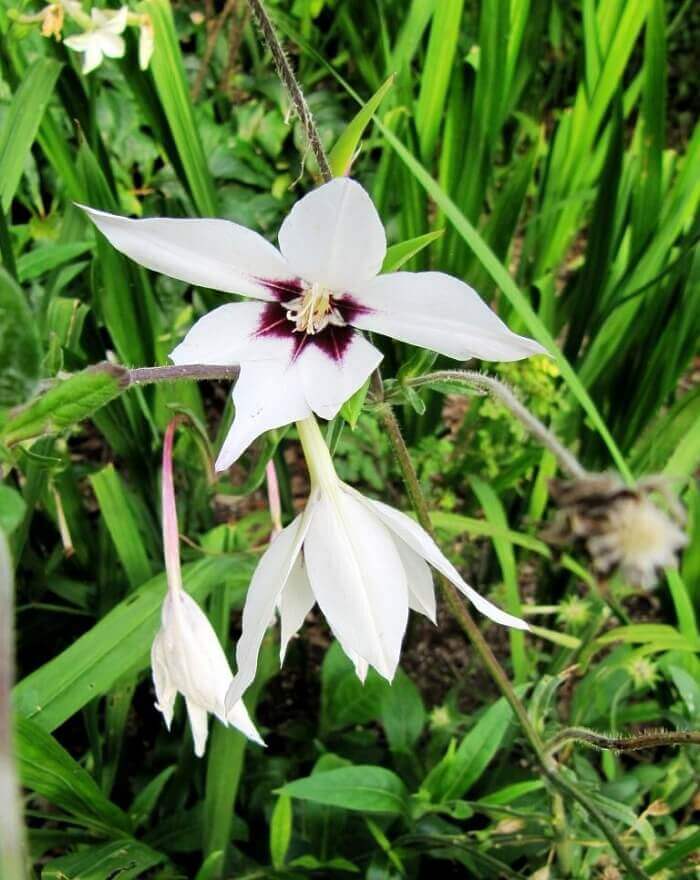

Pests and diseases ... Sensitive to gray rot, rust, mosaic virus. The most dangerous pests are aphids, spider mites and thrips.
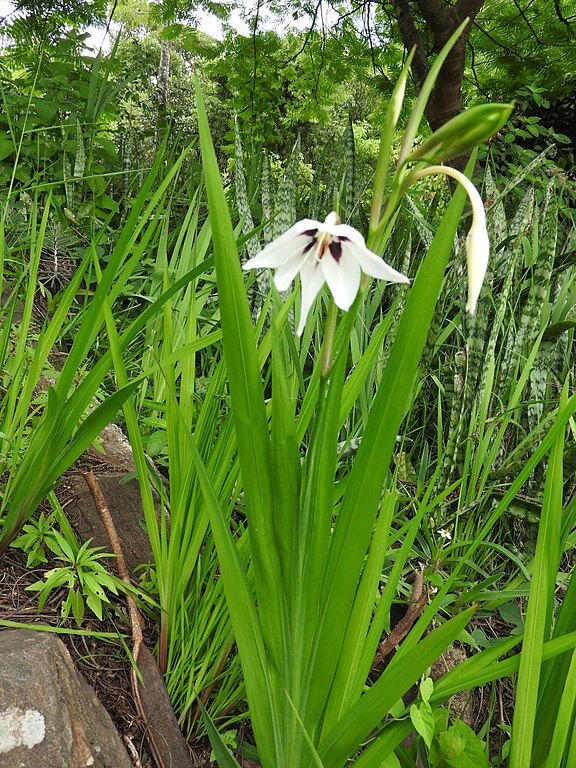

Note.
Hydroponics.
Growing features
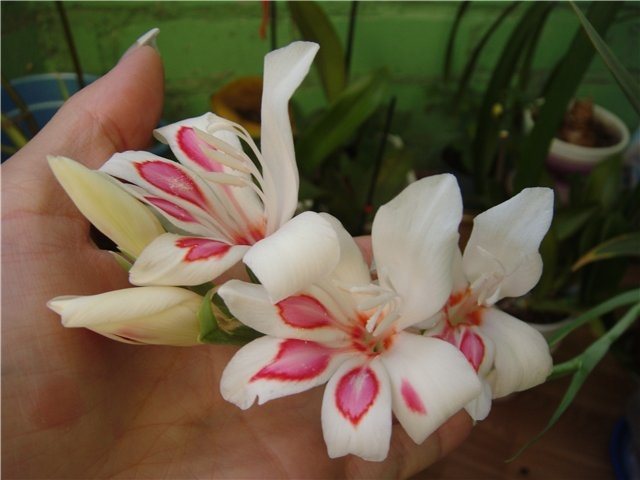

The main enemies of acidants are:
- aphid;
- snails;
- slugs.
Aphids can be easily destroyed by generously spraying the plant with soapy water. If there are too many pests, you can use insecticides like Aktara, Inta-vira or Karbofos. And you can fight snails and slugs manually. If they massively infect plants, then you can use drugs such as Thunder or Thunderstorm.
Among the diseases, fragrant gladiolus is most susceptible to various spots and gray rot. Low temperature and high air humidity contribute to the development of infection. For the prevention of fungal diseases in the rainy season, it is advisable to spray the plants with Fitosporin once a week.And when rusty or dark spots appear, treatment with a 0.2-0.3% Fundazole solution will be required.
Acidantera is a real decoration for the garden. But she is very picky about the conditions of detention and will never grow in the cold. Therefore, an important condition for its cultivation is to provide heat not only during the day, but also at night. If you want to enjoy the delicacy of the inflorescences and their incredible aroma, protect the flowers from the cold by covering them with film at night.
When to plant
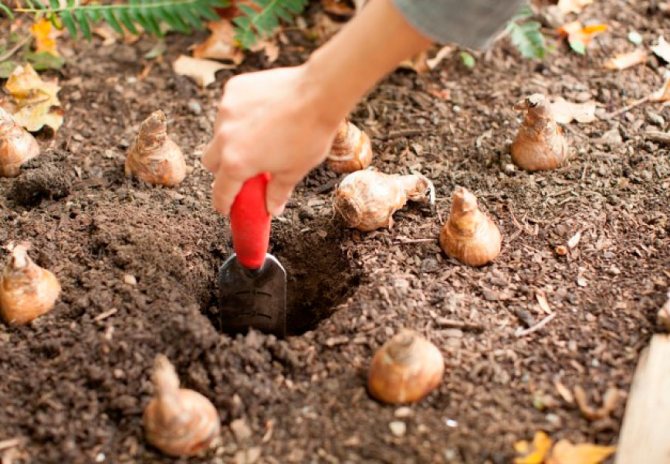

The time for planting fragrant gladiolus bulbs must be calculated, focusing on the climate of the region in which you live. General recommendations are as follows:
- the threat of the return of night frosts must be excluded;
- the soil must be warm enough for the plant to start growing;
- the air temperature at night should not drop below + 5 ... + 8 ° C.
In the south of the country, such a period begins at the beginning of May, and the Moscow region and central Russia - at the end of this month.
Advice! If you live in colder regions, then with the onset of May, plant the acidander in pots of 5-6 pieces. Plants can be kept on a well-lit windowsill until stable warm weather sets in. This approach to growing flowers will allow them to bloom without delay.
Plant features
- Acidantera Muriel is a small perennial plant no more than one and a half meters. Tubers are white, round, bulbous. The diameters are about thirty millimeters with a hard protective film of light brown color.
- Branched shoots on the top of the trunk. Linear or xiphoid leaves are large, green in color, reaching one and a half meters.
- The inflorescences resemble an ear and usually have from three to ten flowers of a light powdery shade, up to fifteen centimeters. The buds exude a pleasant sweetish aroma, a delicacy for bees. The flowers have an elongated tube, with six sharp gradient colored petals.
- There are crimson, purple with an almost black base. Flowering period late summer early autumn.
- The buds open in turn in the direction from bottom to top, this feature allows you to count the flower period of about four weeks. The capsule fruits are filled with seeds.
Selection and pre-planting of bulbs
It is better to buy planting material in domestic nurseries, Dutch bulbs may be too tender.
How to store acidantera bulbs before planting? The disassembled bulbs are treated with fungicides before planting, in order to avoid further damage by root rot, they are kept at a temperature of + 22 ° C for 2 weeks.
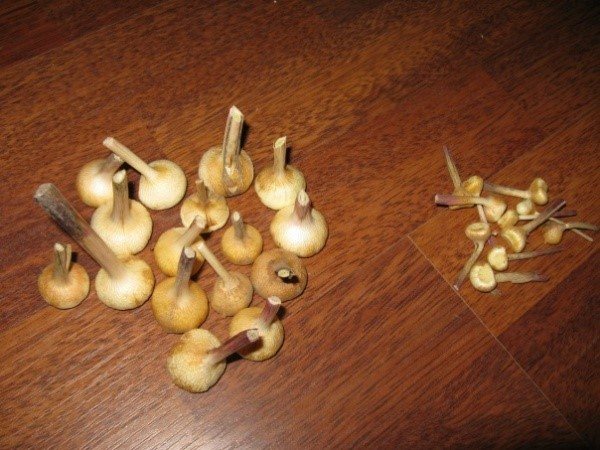

Immediately before planting, it makes sense to soak the bulbs for several hours in any growth stimulator (Epin, Zircon).
The history of the origin of the plant
The Acidanthera type includes about 25 species native to wild Africa. They differ in the color of the buds, the length of the beginning peduncle, the flowering period and the appearance of the tuber. The most common species is Acidantera bicolor, which came to us from the mountainous and tropical regions of East Africa in 1896.
In culture, the variety Muriel, which came to us from Ethiopia, is widespread. Muriel grows naturally on wet rocks and rocks at an altitude of 1200-2500 m above sea level. As a result of crossing the dichroic variety Acidanthera murielae with Acidanthera tunbergenii, a hybrid species of Acidanthera bicolor with larger and earlier flowers was obtained, which bloom 2-3 weeks longer than the parent form.
Acidantera in nature (click to view)
In temperate climates, under favorable conditions, Acidantera reaches a height of 90-100 cm. Leaves develop about half the length of the incipient peduncle. The flowering period falls in the second half of the year - August-September. Flowers are collected in 6-12 pieces in the bosom, have a diameter of up to 12 cm.The perianth ends in a thin tube of six white petals with a contrasting purple spot in the center. In our climatic conditions, flowers are pollinated by butterflies, luring them with bright colors and a lot of nectar.
How to dig up acidander correctly?
When you have trimmed the top of the acidander, the tubers should remain in the soil to gain strength and also provide a supply of nutrients. It is necessary to dig up the tubers only with the onset of the first frost. As a rule, the first frost occurs between September and the end of November, depending on climatic conditions.
Dig up the tubers very carefully., while taking a large supply of soil so as not to damage the fragrant gladiolus bulb. When you have removed the bulb from the soil, you need to clean it from the soil and dry it. Tubers are listened to at an air temperature of about 20 degrees and with intensive air circulation.
The drying period is quite long, it is about 1 month. If there is such a need, then in order to prevent the tubers can be treated with fungicides. This will prevent mold and rot from forming. After drying, it is necessary to clean the bulbs from the scales. Next comes the stage of wintering for tubers..
Care features
Finding the right place is important for the successful cultivation of acidantera. It should be calm and sunny. The soil needs fertile, with a slightly acidic reaction. It is important that the soil is loose and well aerated. Heavy, clayey soils should be mixed with sand. Even before planting, the site is dug up and organic and mineral fertilizing is applied. In order for the air to freely penetrate to the rhizome, it is recommended to periodically weed the soil near the flowers. Mulching the top layer with peat and humus also helps.
Acidantera needs regular watering, it does not tolerate even a short-term drought. However, the stagnation of water in the ground is even worse for it, as it leads to rotting of the bulbs. From May to September, twice a month, a complex of mineral fertilizers for flowers is added to the water for irrigation. If the summer is wet and there is no need for watering, you can evenly sprinkle the powder on the surface of the soil.
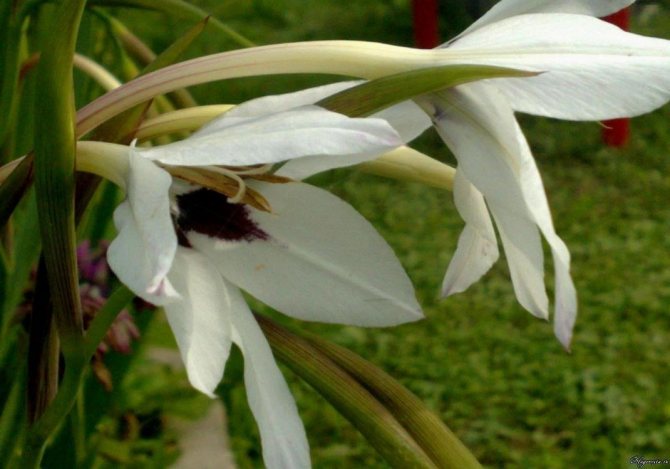

After flowering is complete, you need to cut off the peduncles and part of the foliage. Without this procedure, the acidantera will not have time to prepare the corms for wintering.
With proper care, the plant does not suffer from disease. If the acidantera grows in a damp, cool place, it can suffer from powdery mildew, rust and root rot. The plant is regularly attacked by slugs and snails. In dry weather, aphids, thrips and spider mites join them. Insects are treated with insecticides, slugs are collected by hand.
Bulb propagation in spring
Surplus bulbs Acidantera are sown in shallow grooves of 3 cm. Smaller children are planted separately. Sowing begins in the spring in the second half of April, so that the plant has more time to create quality bulbs. At night, it is recommended to cover the sowing of Acidantera bulbs with a covering material, since the night temperature in April can drop to 2 C, which negatively affects young plants. After 2-3 weeks, the Acidantera bulbs adapt and do not need to be covered. Also, do not forget about etching before planting, because in the early phase of growth, the flower is susceptible to disease.
After the roots have dried well, the babies and the bottom are separated from the mother's bulb.
Reproduction of acidants
Fragrant gladiolus reproduces by seeds and babies. Growing from seeds is a rather laborious task, and only after three years you can count on the appearance of flowers. At the beginning of February, the seeds should be sown in a box filled with nutritious soil. The temperature in the growing room should be +20 degrees. The grown seedlings need to be dived and transplanted into flowerpots or into open ground.There will be no flowers this year. In the fall, they need to be dug up and, as indicated in the previous section, sent to winter. In the spring, plant the small bulbs in the open ground again, and dig up again in the fall. And already in the third year, the tubers will be ready to bloom.
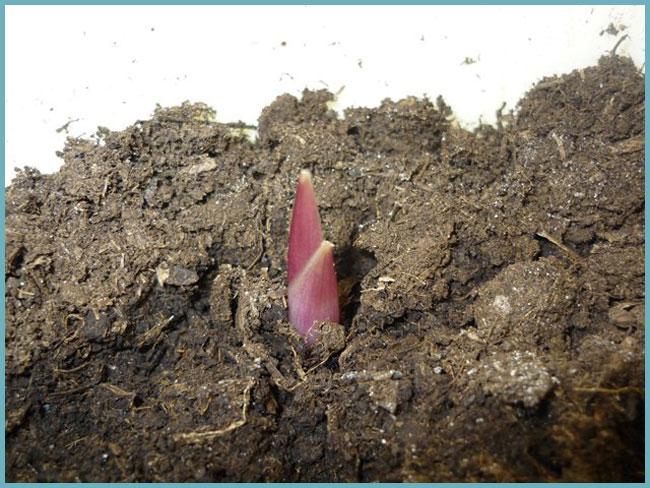

Sprouted Acidantera
Advice! You can not transplant sprouts into a flower garden, but grow them until autumn in flowerpots.
Reproduction by children
It is necessary to separate the children from the bulbs dug out for the winter. After wintering, they need to be planted in the ground (as mentioned earlier). With good care, they can please with flowering already towards autumn.
Important! Before planting, to prevent damage by rot or rust, the tubers must be treated with a fungicide.
If the kids are too small, they can be grown in separate beds.

